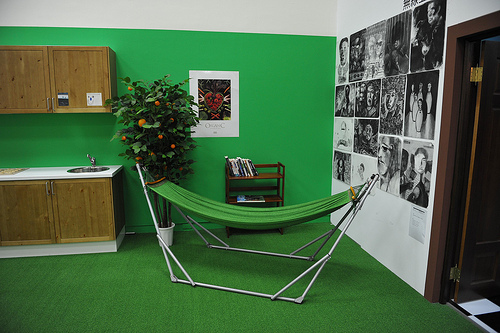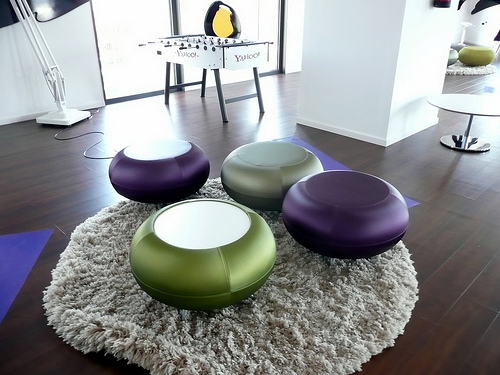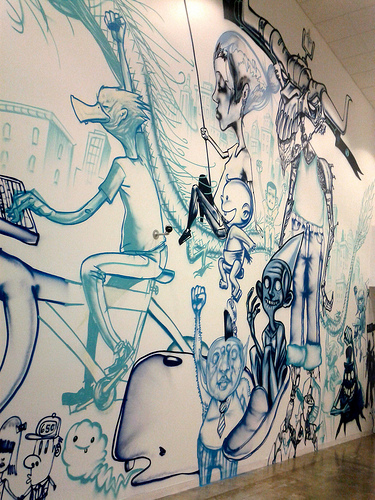Have you ever got to the end of a working day and thought: “I may as well just sleep here tonight”? Neither have we.
But if you worked for one of the world’s coolest companies, such as Google, you might feel differently. The global tech giant’s offices feature everything the dedicated employee could need, including onsite gyms, doctors, canteens and, most recently, sleeping pods.
It’s even been rumoured that there’s an informal competition to see how long a Google employee can “live” at one of the company’s HQs – the record apparently being around the two year mark.
But why is this blurring between work and home life occurring, and will there one day be no distinction between the two?
Is it an office or a house?
In the early 1980s, cubicle mania was at its height and offices were bland, colourless and divided into individual workstations. It was also the height of power dressing – which meant suits, heels and shoulder pads.
Then came Apple in 1984 and everything changed. The brand’s team did something the world had never seen before, and wore grey hoodies to a formal launch.
Since then, tech giants such as Google, Facebook and Yahoo have paved the way for a relaxed, ‘cool’, working culture – and the attitude has filtered down into office design.
Walk into the offices of one of these companies and you’re likely to see hip youths in jeans munching on cereal, and the traditional water cooler and vending machine replaced by cafes and smoothie makers.
So, aside from Google, which other offices are leading the movement?
Yahoo
Caption: Inside Yahoo’s Barcelona offices
Whilst Yahoo may have lost out to Google in the cool stakes, the company’s offices certainly don’t let its employees down. Perks include clustered seating, table football and cafes stocked with free snacks, juice and coffee.
Hootsuite
Hootsuite’s Vancouver offices are located in an old police station and feature a private yoga studio, gym and nap room. Plus, there’s free beer on Fridays, on tap.
Caption: Graffiti art inside the Facebook offices.
A pioneer of the ‘cool’ office, Facebook headquarters offer employees everything from coffee shops to barbers. Walls in work areas are covered in blackboards, which employees are encouraged to decorate how they like.
Mind Candy
Described by the Telegraph as having ‘Britain’s coolest office’, Mind Candy has turned their workplace into a place of play, with everything from table tennis to slides and colour-in walls.
Why is work and home life becoming blurred?
So, why are our offices morphing into an extension of our home life? Over the last few decades, the things we do in both places have become harder to distinguish.
As technology has developed, workers have found themselves untethered from the office, meaning that they can do everything from answer emails to participate in conference calls in the comfort of their homes.
Consequently, there has been a blurring between the two, with the home becoming more like the office and the office becoming more like the home.
Ironically, companies such as Yahoo and Google, who have offices designed to look like a home, are increasingly demanding that their staff don’t work from home – a leaked memo from Yahoo Chief Executive Marissa Mayer revealed that she had ordered an end to remote working.
Of course, providing facilities such as gyms, barbers, doctors and restaurants has its benefits for companies such as Facebook and Google. Having these amenities on tap means that employees can spend more time in the office, and consequently, more time working.
Plus, the old saying that ‘a happy workforce is a productive workforce’ has been proved to be true, with studies showing that happiness makes people around 12% more productive. Whilst a happy workforce is dependent on a variety of factors, such as quality of management and wages, having a slide or a nap room has to help – surely?
The blurring of the office with home life does of course have its critics. The obvious problem is that the lack of separation can leave us unable to switch off and relax. There’s also the frightening statistic that 70% of time we spend at work computers is cyber-loafing, suggesting that maybe we feel a little too at home.
Despite the arguments though, it seems to be a trend that’s unlikely to fade quickly, particularly as the ‘fun’ office caters for Generation Y’s (birth years ranging from the early 1980s to the early 2000s) preferred working style, which is motivated by a need for collaboration and social interaction.
What are your views on the blurring of the office with the home? And, if you worked at Google, would you sleep there?
Image one by Julian Stallabrass
Image two by codepo8
Image three by codepo8




